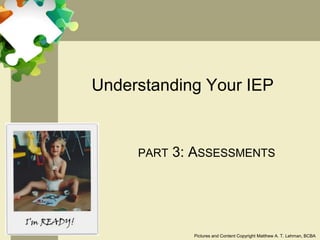
Understanding Your IEP Assessments [Online Version]
- 1. Understanding Your IEP PART 3: ASSESSMENTS Pictures and Content Copyright Matthew A. T. Lehman, BCBA
- 2. Why Do We Assess • Required by law – ADA/504 and IDEA • To Understand What Our Kids NEED – Guides Services • Track Progress – Is the program working?
- 3. Difference Scores • Personal Strength / Weakness – Significant discrepancy between areas of our child’s performance and abilities • Normative Strength / Weakness »Significantly discrepancy between our child’s ability and that of the general population
- 4. HELP! WHAT DO ALL THESE MEAN?
- 5. Taking To The Next Level • The meat of any report is the Subtests and Scaled Scores – don’t fall for the bottom line trap of an IQ score • D-KEFS : 10 ± 3 – What does this mean? • Scores of 8-12 are IDENTICAL • Differences MUST be 3 points or greater or they are NOT significant • Hypothetical – Ability Score: 14 THIS is what – Performance: 11 to look for! • Answer: Testing shows a significant discrepancy between ability and performance
- 6. Practice (with Scaled Scores) • Ability Score: 3 *Normative weakness *NO discrepancy *needs support, probably beyond • Performance: 1 current biological capacity *Average Ability • Ability Score: 10 *Discrepancy *needs support, look to why • Performance: 7 unable to perform at capacity- what is interfering?? *Normative strength • Ability Score: 16 *Discrepancy *needs support, look to why • Performance: 10 unable to perform at capacity- what is interfering??
- 7. What if they don’t have Scaled Scores? • ASK for them! • If they can’t provide / look them up, this may be sufficient to ask for an IEE as they are not demonstrating competency in assessment. – Remember doing this math in your head isn’t easy, give them a chance to actually do it on a computer
- 8. So Wait What Does That Score Mean? • ASK! – They have to explain it till you get it Side Note • IQ = Ability to get needs met at the time of the test in the language and communication mode of the test – STOP & THINK • what does this mean • Have the expert explain this to parents, they probably need to hear it at least once to understand and accept their child’s needs – look for parents saying “but my child can do…” “but he does understand, even if he can’t tell me”
- 9. So Which Assessments To Use? • Direct • Report Based Assessment Assessment – ADOS – ABAS-2 – D-KEFS – BASC-2 – K-ABC – BRiEF – WISC-IV – Conners3 – WJ – SSIS Which Column Should We Use?
- 10. Choosing Assessments (continued) • Direct Assessments • Report Based Assessments – Concern about adults – “Fast” and easy ability to respond – Doesn’t require extensive – Wide discrepancies training between adult reports – Bypasses child compliance – Difficult to assess by observation or no one – Less disruptive qualified to make such observations – Often just as reliable but subject to adults opinions – Time Consuming (usually controlled for) – Requires child compliance
- 11. General or Specific? – and WHY • Global Batteries • Specific to child’s needs – WISC / WAIS – ADOS-2 – K-ABC – D-KEFS – ABAS-2 – PDDBI – WJ Global: Tests a wide array of ability and performance scales, generally not diagnosis specific Specific: Tests a specific type of need or for a specific area of need often diagnosis or need specific including for the purpose of making a diagnosis
- 12. Knowledge: How To Use It • Ask the school psychologist WHY a specific test vs another? – Be specific on tests – Have Your OWN Expert Ask probing questions • Before & AT the meeting – If past reports have been invalid or inconclusive, try direct assessments • Non-compliance with tests IS important information
- 13. Examples • Disclaimer: Consult an expert in clinical assessments before doing more then asking why one or the other. • Attention problems – K-ABC results are less impacted then the WISC or WAIS by attention difficulties because the tools are more colorful and engaging. • Adaptive Skills – PDD-BI and ABAS-2 have a lot of overlap, but the PDD-BI is specific for kids suspected of an autism spectrum diagnosis • Test Weaknesses – ADOS doesn’t assess peer interpersonal deficits • Adding A Test to Broaden Application to IEP planning – D-KEFS highlights performance vs ability differences – Conners, BASC, SRS look more at current levels
- 14. Understanding the Graphs Graph from NAC 2012 Report
- 15. Data Trends Graph from NAC 2012 Report
- 16. A-B-A-B Graphs: Proof of Causality Pre-IEP supports in place winter/spring/ supports back summer break in place -Stronger then a double blind randomized trial. Graph from NAC 2012 Report
- 17. Knowledge: How To Use It • Graphing is proof of efficacy and if it isn’t working – Ask for it if parents are concerned about efficacy • A-B-A-B graphing APPLIED – Use this to show that removing a support didn’t work or that its too soon to fade back that support • For non emergency/ non safety issues – Let them know we are willing to try what they suggest but we have concerns – I may give the school 30 or 60 days to show if it works – I setup the request for the follow up meeting right at the current IEP
- 18. Putting it All Together • Formulate and write notes about what you want to say and ask • Remember the school might be right – reality test! • Know your comfort zone and bring support • Take Your Time!
